Overview
ADHD combined presentation is a neurobehavioral condition that can deeply impact children’s daily lives, affecting both their academic performance and social interactions. This condition is characterized by a blend of inattentive and hyperactive-impulsive symptoms, which can be challenging for both children and their families. Understanding these symptoms is crucial, as it lays the foundation for effective support.
It’s important to recognize that each child is unique, and their needs may vary. A comprehensive approach to treatment is essential, which may include:
- Medication
- Behavioral therapy
- Supportive networks
These resources can be invaluable in addressing the specific challenges your child may face.
As parents, it’s natural to feel concerned and seek the best for your child. By learning more about ADHD combined presentation, you can empower yourself and find the right strategies to help your child thrive. Consider reaching out to professionals and support groups, as they can provide guidance and share experiences that resonate with your journey. Together, we can foster understanding and create a nurturing environment for our children.
Introduction
In a world where understanding neurobehavioral conditions is more crucial than ever, ADHD Combined Presentation presents a complex challenge for many families. This condition, characterized by a blend of inattentive and hyperactive-impulsive symptoms, can significantly impact children's academic performance, social interactions, and overall well-being. As awareness grows, so does the need for effective strategies to navigate the intricacies of ADHD.
From recognizing symptoms to exploring treatment options and building supportive networks, this article delves into the essential aspects of ADHD Combined Presentation. It aims to provide valuable insights for parents, advocates, and educators alike. Through a comprehensive exploration of its causes, diagnosis, and management strategies, readers will gain a deeper understanding of this multifaceted condition. Ultimately, this knowledge equips families with the tools to foster success in those affected.
We invite you to join us on this journey, as together we explore the paths to understanding and support.
What is ADHD Combined Presentation?
ADHD combined presentation is a neurobehavioral condition that encompasses a blend of symptoms from both the inattentive and hyperactive-impulsive categories. Children with ADHD combined presentation often face challenges in sustaining attention, managing impulses, and regulating their activity levels. These overlapping symptoms can significantly impact their daily lives, affecting academic performance, social interactions, and overall well-being.
Recent studies indicate that the occurrence of ADHD combined presentation among children is noteworthy, with estimates suggesting it affects a significant percentage of the pediatric population in 2025. Understanding the characteristics of this condition is essential for parents and advocates. Common traits include:
- Difficulty following through on tasks
- Excessive fidgeting
- Challenges in waiting for their turn in conversations or activities
Real-world examples illustrate the complexities of ADHD combined presentation. For instance, consider a young individual who excels in creative tasks but struggles with organization and time management. This case highlights the dual nature of strengths and challenges often seen in these individuals. Furthermore, expert opinions emphasize the importance of a holistic approach to managing attention deficit hyperactivity disorder, incorporating coaching and therapeutic interventions tailored to each child's unique needs.
As noted by Elena Cox, a senior data reporter, "The integration of holistic treatments is becoming increasingly vital for effectively managing the condition, as it addresses its multifaceted nature."
Statistics reveal that 30.5% of adults with current attention deficit hyperactivity disorder have utilized telehealth services to obtain a prescription for medication since March 2020. This trend underscores the growing awareness of the need for accessible treatment alternatives, which can also benefit youngsters with ADHD combined presentation.
As we progress through 2025, it is anticipated that a significant majority of adults with attention deficit hyperactivity disorder will recognize positive aspects of their condition, such as enhanced creativity and empathy. This perspective is crucial for fostering a nurturing environment for youth with ADHD in its mixed form, motivating guardians and supporters to focus on both the challenges and the advantages associated with this condition.

Recognizing Symptoms of ADHD Combined Presentation
Understanding the symptoms of ADHD combined presentation is essential, as they can significantly impact a young person's daily life. These symptoms can be grouped into three main categories:
- Inattention: Many children find it hard to maintain focus on tasks, often making careless mistakes and struggling to organize their activities. This can lead to challenges in academic settings, where attention to detail is so important.
- Hyperactivity: Signs of hyperactivity may include excessive fidgeting, an inability to stay seated, and a tendency to talk more than usual.
- Impulsivity: Impulsive behaviors can manifest as interrupting others, having difficulty waiting for one's turn, and making quick decisions without thinking about the consequences. Such actions can complicate social situations and relationships with peers.
Research shows that nearly 1 in 5 youth with Medicaid receive attention deficit care from nurse practitioners and psychiatric nurses, underscoring the importance of professional support in managing these symptoms. Additionally, young individuals diagnosed with both ADHD and co-existing conditions, such as anxiety or learning disorders, often face more severe symptoms than those with ADHD alone, as noted by the CDC. This highlights the need for careful monitoring of behaviors across different environments, like home and school, since symptoms can vary significantly based on the setting.
A case study on racial and ethnic disparities in attention disorders reveals that White non-Hispanic youths have the highest occurrence of attention issues at 13.4%, followed by Black non-Hispanic individuals at 10.8% and Hispanic youths at 8.9%. This illustrates how ADHD symptoms can present differently across various racial and ethnic backgrounds, emphasizing the need for tailored approaches in diagnosis and treatment.
Real-life examples can shed light on how these symptoms manifest uniquely. For instance, a young person might be able to focus intently on a video game for hours yet struggle to complete homework assignments. Recognizing these nuances is crucial for effective intervention and support.
By becoming aware of the typical indicators of ADHD combined presentation, parents and supporters can more effectively advocate for their children's needs and seek out appropriate resources and strategies to foster their growth. It is also important to note that adults with combined type ADHD must exhibit symptoms of both inattention and hyperactivity/impulsivity, which can vary in prominence and intensity, further informing how these symptoms may evolve over time.
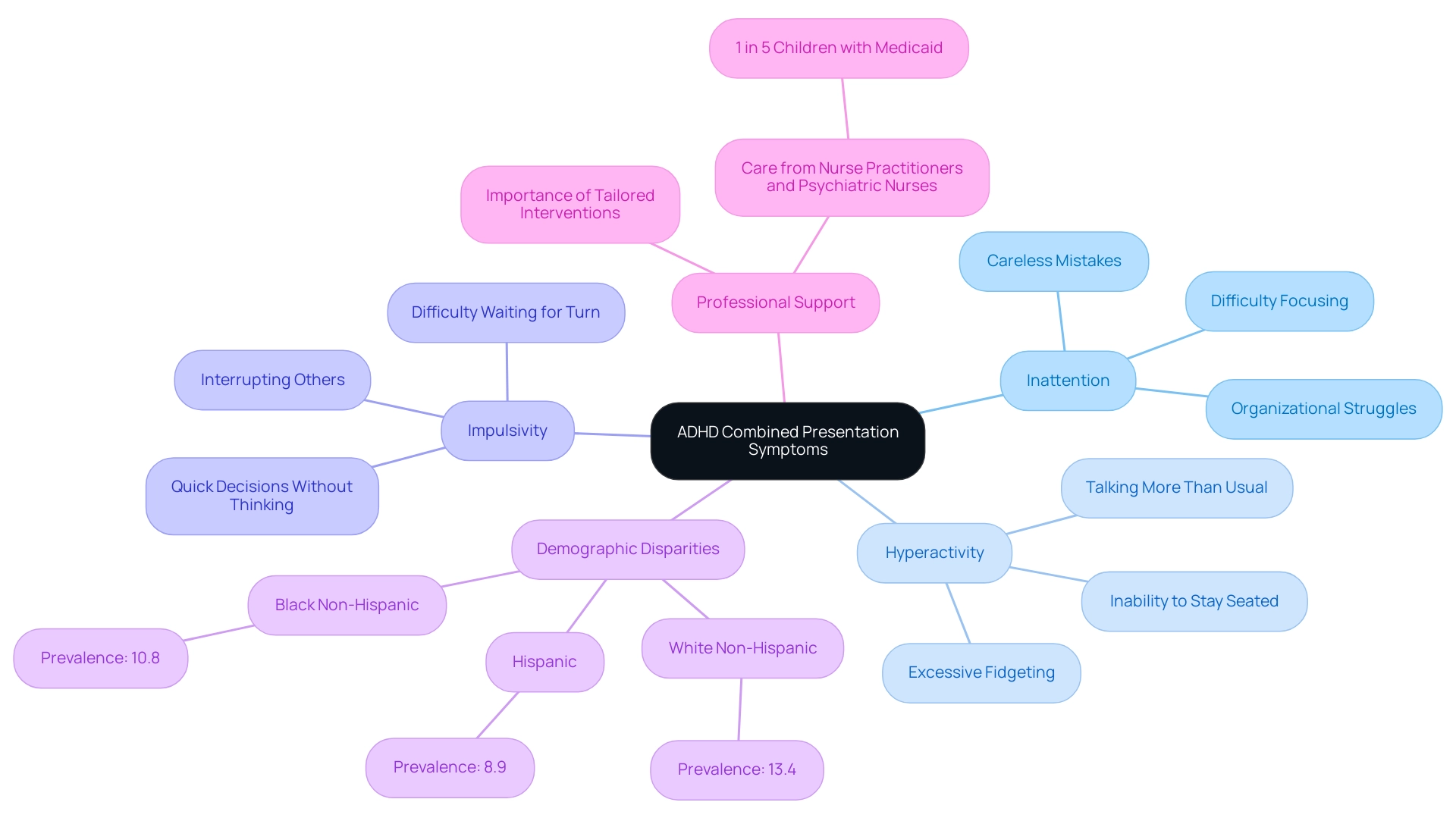
Diagnosis of ADHD Combined Presentation: Key Considerations
Diagnosing ADHD Combined Presentation is a journey that requires the careful evaluation of a qualified mental health professional, focusing on several key considerations that are essential for understanding this condition:
- Symptom Criteria: To meet the diagnostic criteria, individuals must exhibit at least six symptoms of inattention and six symptoms of hyperactivity-impulsivity over a minimum duration of six months. This dual symptomatology is crucial for a diagnosis of ADHD combined presentation.
- Impact on Functioning: The symptoms must significantly interfere with or diminish the quality of social, academic, or occupational functioning. Understanding this impact is vital, as it highlights how attention deficit hyperactivity disorder can affect daily life and overall well-being.
- Developmental Context: Symptoms should manifest in various environments, such as home and school, and cannot be better explained by another mental disorder. This multi-setting requirement ensures that the diagnosis reflects a consistent pattern of behavior.
A comprehensive assessment typically includes a combination of interviews, behavior rating scales, and valuable input from parents and teachers. Recent statistics reveal that as of 2022, about 11.4% of youth aged 3–17 years in the U.S. have been identified with attention deficit hyperactivity disorder, with 92.6% of those still holding the diagnosis. This underscores the importance of accurate and timely evaluations.
Looking ahead to 2025, it is anticipated that approximately 14.1 million American adults with attention deficit hyperactivity disorder will face career challenges, emphasizing the long-term effects of the condition if not accurately diagnosed and managed. Current best practices in diagnosing ADHD combined presentation stress a collaborative approach, bringing together insights from various stakeholders to ensure a holistic understanding of the child's behavior and needs. As a coach noted, "While medication will remain a cornerstone, it’s clear that coaching can play a critical role in helping individuals develop the tools for lasting success."
This highlights the importance of considering coaching as part of a comprehensive management strategy.
Moreover, it is noteworthy that 81.7% of girls with attention deficit hyperactivity disorder have at least one co-occurring condition, which adds complexity to the diagnosis and management of the disorder. As the stigma surrounding attention deficit hyperactivity disorder continues to diminish, more resources are becoming available, empowering families and advocates to seek the support necessary for effective management and intervention.
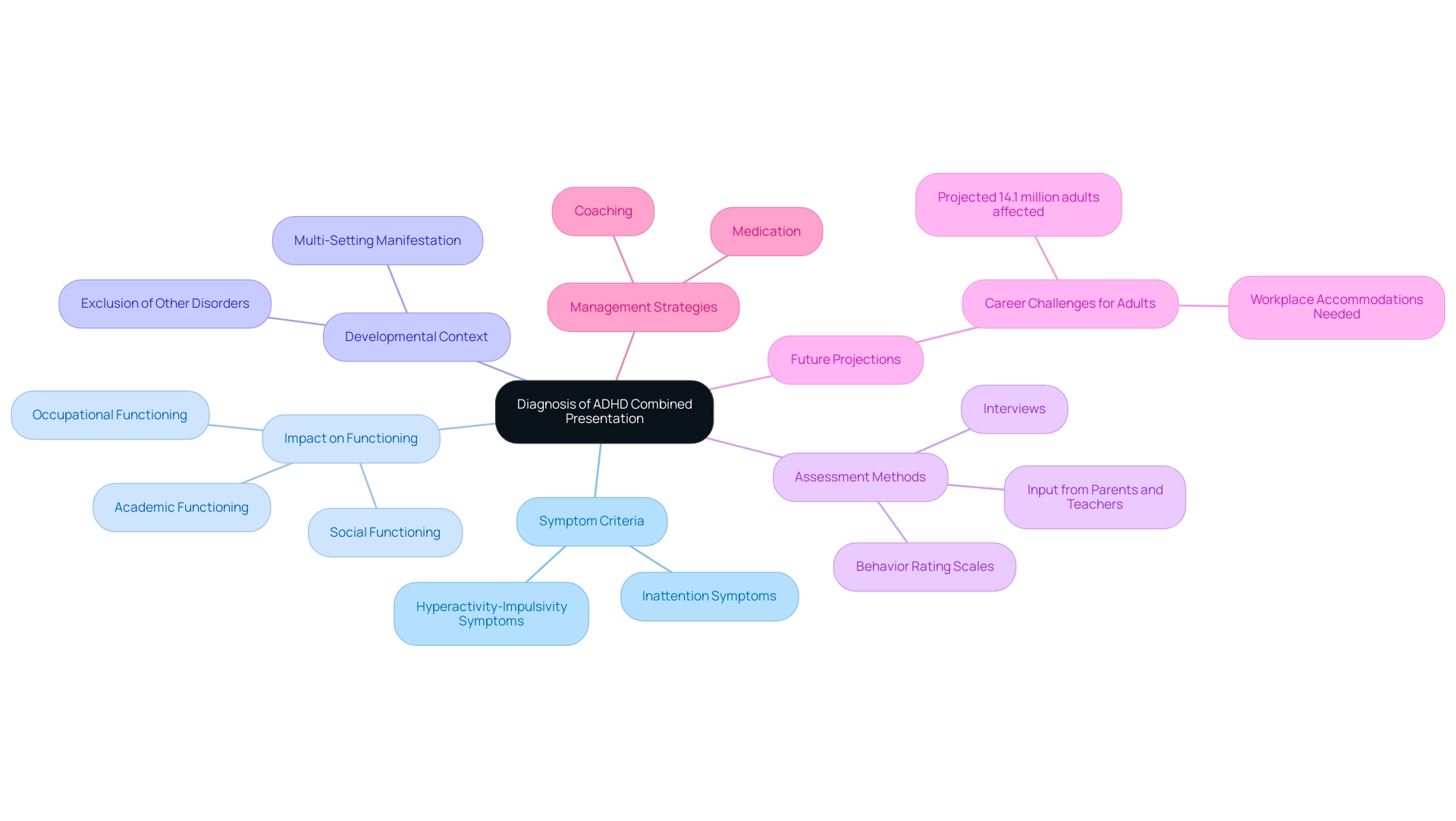
Understanding the Causes of ADHD Combined Presentation
The causes of Attention Deficit Hyperactivity Disorder Combined Presentation are complex and multifaceted, encompassing a variety of factors that can deeply impact families.
Genetic Factors: Research highlights the hereditary nature of this condition, revealing that it often runs in families. Recent genetic studies have identified rare missense or disruptive variants in candidate genes linked to ADHD, suggesting a biological underpinning that warrants further exploration. An older study indicated that the rate of established syndromes was sufficiently low in ADHD that genetic testing is not warranted in individuals without intellectual disability (Dr. M. O’Donovan). This information can be crucial for parents seeking to understand their child's experiences.
Environmental Influences: Various environmental factors play a crucial role in the development of ADHD combined presentation. Prenatal exposure to toxins, such as alcohol and nicotine, low birth weight, and early childhood adversities—including trauma and neglect—have all been associated with a heightened risk of developing ADHD combined presentation. These influences underscore the importance of a supportive environment during crucial developmental phases, highlighting the need for nurturing surroundings.
Neurobiological Factors: Neurobiological research has uncovered variations in brain structure and function among individuals with ADHD combined presentation, specifically in areas associated with attention and impulse control. These differences can manifest as challenges in regulating behavior and maintaining focus, further complicating the condition. As technology advances in genomics and neurobiology, we can expect a deeper understanding of ADHD's etiology, which may lead to more effective treatment options.
Understanding these diverse factors equips parents and advocates with the knowledge to approach ADHD combined presentation with empathy and informed strategies. As ongoing research continues to unveil the intricate interplay between genetic predispositions and environmental influences, it becomes increasingly clear that a comprehensive understanding of ADHD combined presentation is essential for effective support and intervention. For instance, the genetic correlations observed between ADHD and other disorders raise questions about the underlying reasons for these links, necessitating further investigation using epidemiological designs and genomic methods to clarify their implications for treatment.
Additionally, the half-life of atomoxetine, a medication used to treat ADHD, ranges from 5.2 hours in rapid metabolizers to 21.6 hours in slow metabolizers. This variability highlights the importance of personalized treatment approaches, as what works for one child may not work for another. Recent exome sequencing studies have also discovered rare variants in candidate genes related to ADHD among patients compared to controls, underscoring the relevance of current research in understanding the condition.
As you navigate the complexities of ADHD combined presentation, remember that you are not alone. Your experiences matter, and sharing them can foster a supportive community. Consider reaching out to professionals or support groups for guidance and connection.
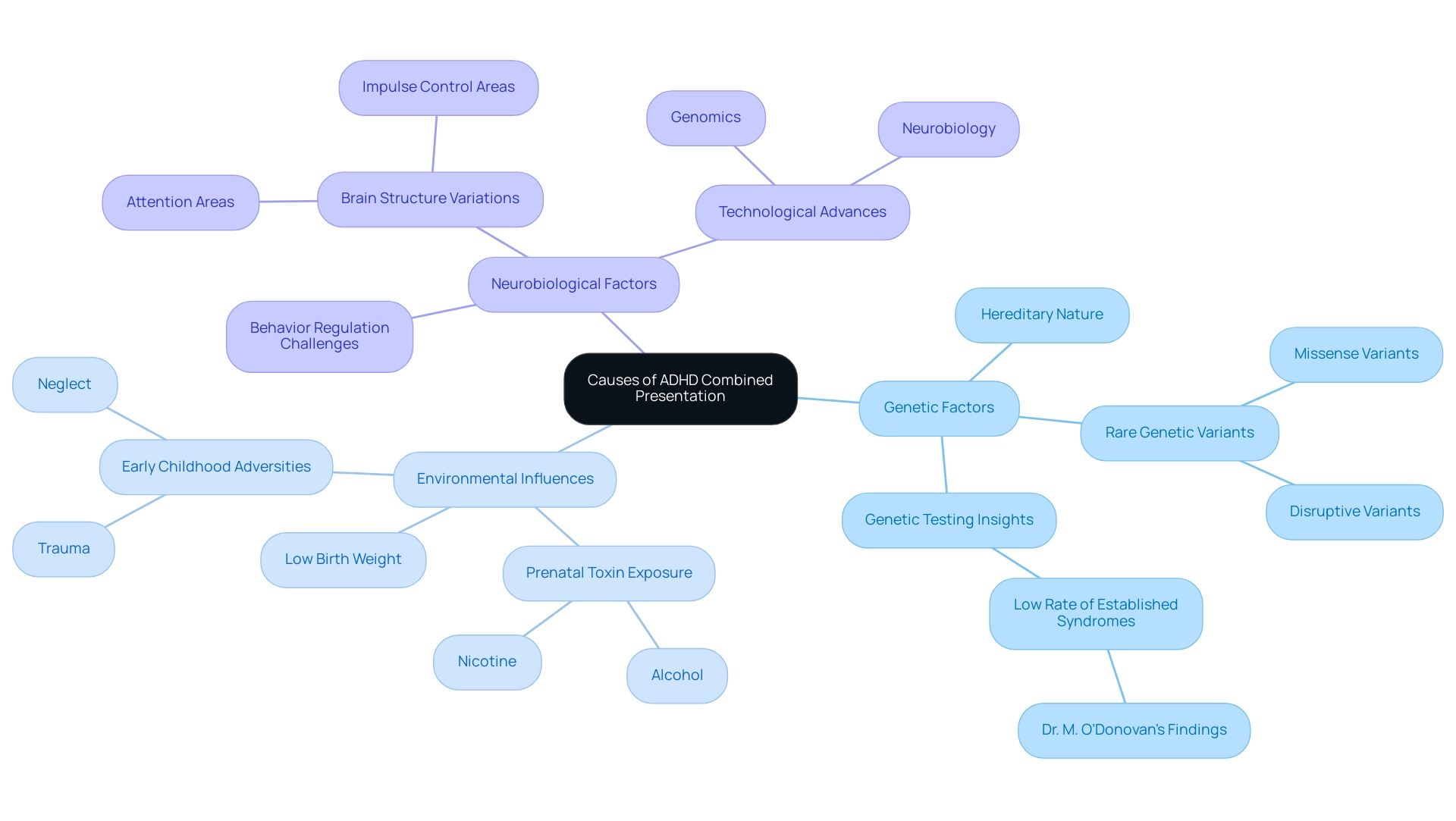
Effective Treatment Strategies for ADHD Combined Presentation
Navigating effective treatment strategies for ADHD Combined Presentation can feel overwhelming, but a comprehensive approach can make a significant difference. Here’s a closer look at various modalities that can support your child:
- Medication: Stimulant medications, like methylphenidate and amphetamines, are often prescribed and have been shown to alleviate symptoms for many children. It's important to note that non-stimulant options, such as bupropion and modafinil, are also available. However, these may come with specific side effects, including irritability and decreased appetite. Understanding the effectiveness and potential side effects of these medications is crucial, especially considering that about 29% of young individuals with ADHD may also have concurrent autism spectrum disorder (ASD). This statistic underscores the importance of tailored treatment methods that consider the unique needs of each child. As Stichting Eunethydis emphasizes, "New research should be funded urgently to assess long-term effects of these drugs," highlighting the need for continued investigation into ADHD medications.
- Behavioral Therapy: Behavioral interventions are vital in helping children develop essential coping strategies, improve organizational skills, and manage impulsivity. These therapies can be customized to meet individual needs, providing flexibility for families seeking support.
- Guardian Training: Educating guardians on effective behavior management techniques is essential. Training programs empower parents to implement strategies that foster their child's development, creating a nurturing home environment conducive to learning and growth.
- School Accommodations: Collaborating with educators to establish individualized education plans (IEPs) or 504 plans is critical for providing the necessary support in academic settings. These accommodations can help students with ADHD Combined Presentation thrive in school by addressing their unique learning needs.
- Case Studies: Research exploring the relationship between genetic variants and the efficacy of medications like methylphenidate reveals the complexity of ADHD treatment. For instance, studies indicate that certain genetic profiles may influence how well a young individual responds to medication, reinforcing the importance of personalized treatment approaches.
By integrating these strategies, you can create a supportive framework that addresses the multifaceted challenges associated with ADHD Combined Presentation. Together, we can enhance the quality of life for affected children and empower families on this journey.
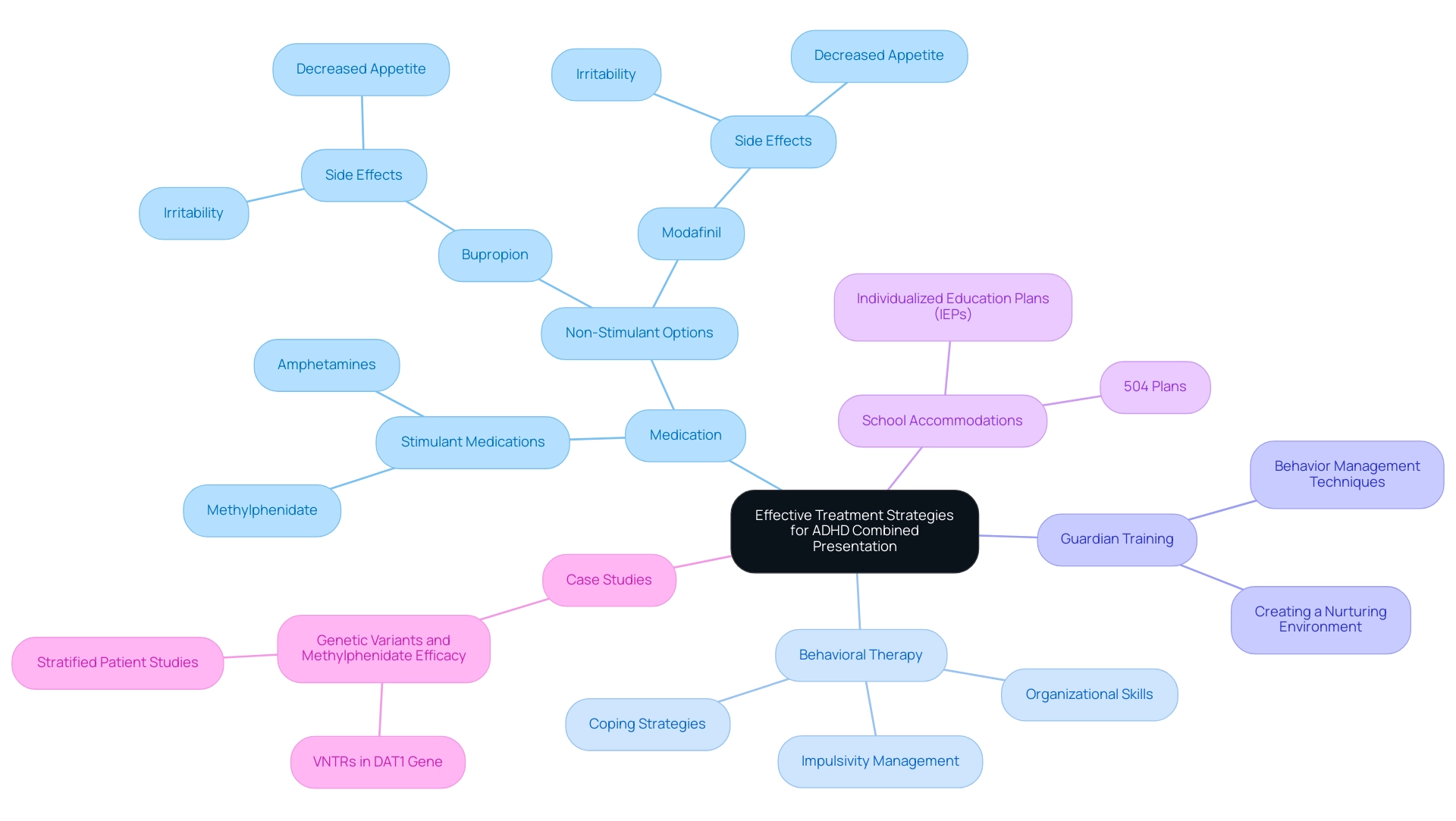
Navigating Daily Life with ADHD Combined Presentation
Navigating daily life with ADHD combined presentation can be challenging, but with effective strategies, outcomes can significantly improve. Here are several approaches to consider:
-
Establish Routines: Consistent daily routines are vital for individuals with ADHD, as they provide structure and predictability. A morning routine that includes specific tasks—like getting dressed, having breakfast, and preparing for school—can empower young individuals to manage their time and responsibilities more effectively.
-
Minimize Distractions: Creating a distraction-free environment is essential, especially during homework or study sessions. Designating a quiet, organized space for learning can enhance focus and productivity. Limiting access to electronic devices during these times can further reduce interruptions.
-
Use Visual Aids: Visual tools such as calendars, checklists, and timers can be invaluable in assisting young learners with organizing tasks and managing their time. For instance, a color-coded calendar can visually represent daily activities, while a checklist can provide a sense of accomplishment as tasks are completed.
-
Encourage Open Communication: Maintaining open lines of communication with educators, caregivers, and the young one is crucial. Regular check-ins can ensure that everyone is aligned on support strategies and expectations, fostering a collaborative approach to managing attention deficit hyperactivity disorder.
-
Real-World Examples: Many families have found success by implementing structured routines. One family established a 'homework hour' where all distractions are minimized, and everyone in the household participates in focused work. This not only assists the child with ADHD but also fosters a supportive atmosphere for siblings.
-
Expert Advice: Experts recommend that parents remain flexible and willing to adjust routines as needed. What works one week may need tweaking the next, so being adaptable is key to finding the right balance. As noted by Luis Augusto Rohde, who has consulted for major pharmaceutical companies, understanding the nuances of ADHD treatment is essential for effective management.
-
Treatment Options: It's important to recognize that management for ADHD combined presentation typically involves medication and behavioral therapy, with stimulant medications being effective in about 70% of patients. This highlights the importance of a comprehensive approach to managing ADHD, as emphasized in the case study titled "Diagnosis of Attention Deficit Hyperactivity Disorder: Importance of Comprehensive History," which underscores the need for thorough assessments across multiple settings.
By incorporating these strategies into everyday routines, guardians and advocates can help youngsters with Attention Deficit Hyperactivity Disorder navigate their challenges more effectively, ultimately leading to enhanced concentration, organization, and overall wellness.
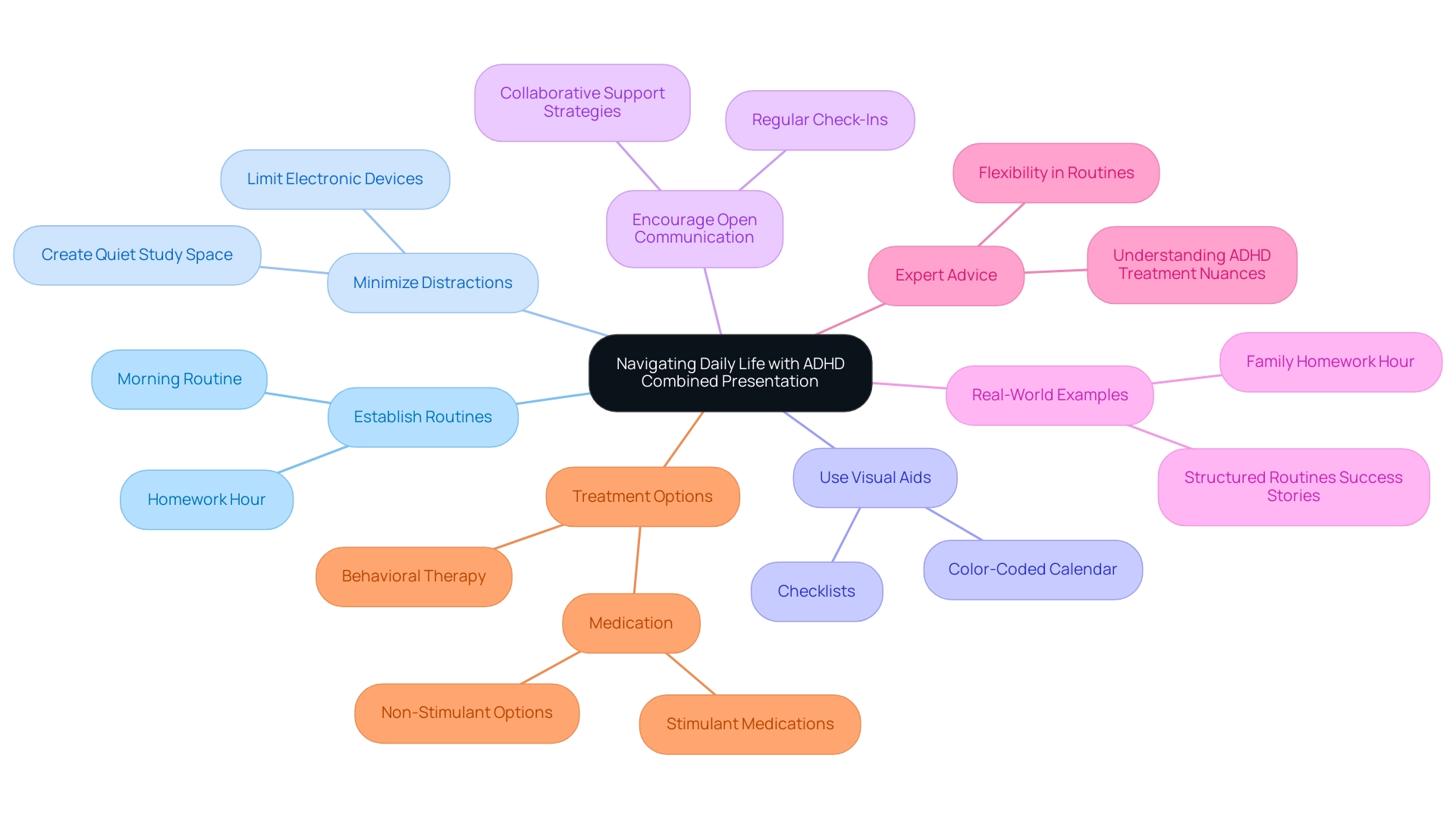
Building a Support Network for Parents and Advocates
Establishing a strong support network is essential for caregivers and advocates of children with ADHD combined presentation. Such networks not only provide emotional support but also practical resources that can significantly improve outcomes for families. Consider these key components:
- Support Groups: Engaging with local or online support groups fosters a sense of community and shared understanding among caregivers facing similar challenges. These groups often serve as a safe space for sharing experiences and strategies, which can be invaluable for emotional resilience.
- Educational Resources: Organizations like CHADD (Children and Adults with Attention-Deficit/Hyperactivity Disorder) offer a wealth of information tailored to families. Their resources consist of guides on handling attention deficit hyperactivity disorder symptoms, comprehending educational rights, and utilizing community services, which are essential for informed advocacy.
- Professional Guidance: Consulting with mental health experts who specialize in attention deficit hyperactivity disorder can provide caregivers with tailored strategies and support. As emphasized by Dennis et al., policy changes promoting education and training in mental health are strongly advised, highlighting the necessity for accessible resources for caregivers. These specialists can assist families in managing the intricacies of attention deficit hyperactivity disorder, offering guidance on effective behavioral strategies and coping techniques.
- Advocacy Organizations: Collaborating with advocacy groups enables guardians to efficiently navigate educational and healthcare systems. These organizations frequently offer training and resources that empower parents with the information required to advocate for their offspring's needs.
Statistics show that 22% of teenagers have participated in yoga in the past year, emphasizing a rising trend towards holistic methods that can enhance conventional treatments for attention disorders. This trend highlights the significance of emotional support and community involvement in managing attention deficit hyperactivity disorder. Furthermore, studies show that parental knowledge significantly influences adolescents' risk-taking behaviors, reinforcing the importance of informed parenting in managing ADHD.
Real-world examples of successful support networks illustrate their impact. For instance, a recent analysis of healthcare claims data revealed that many children with attention deficit hyperactivity disorder receive care from pediatricians, emphasizing the reliance on primary care providers over specialists, particularly among those with Medicaid. This trend underscores the necessity for guardians to establish relationships with healthcare professionals who comprehend attention deficit hyperactivity disorder and can provide extensive assistance.
In 2025, the environment of resources for advocates of children with attention deficit hyperactivity disorder continues to evolve, with various support groups and advocacy organizations emerging to address the needs of families. By actively participating in these networks, parents can enhance their own understanding while contributing to a collective effort that benefits all families navigating the challenges of ADHD combined presentation. It is important to acknowledge that while the study's methodology was rigorous, the limitations of cross-sectional data prevent causal conclusions, ensuring a balanced view of the statistics presented.
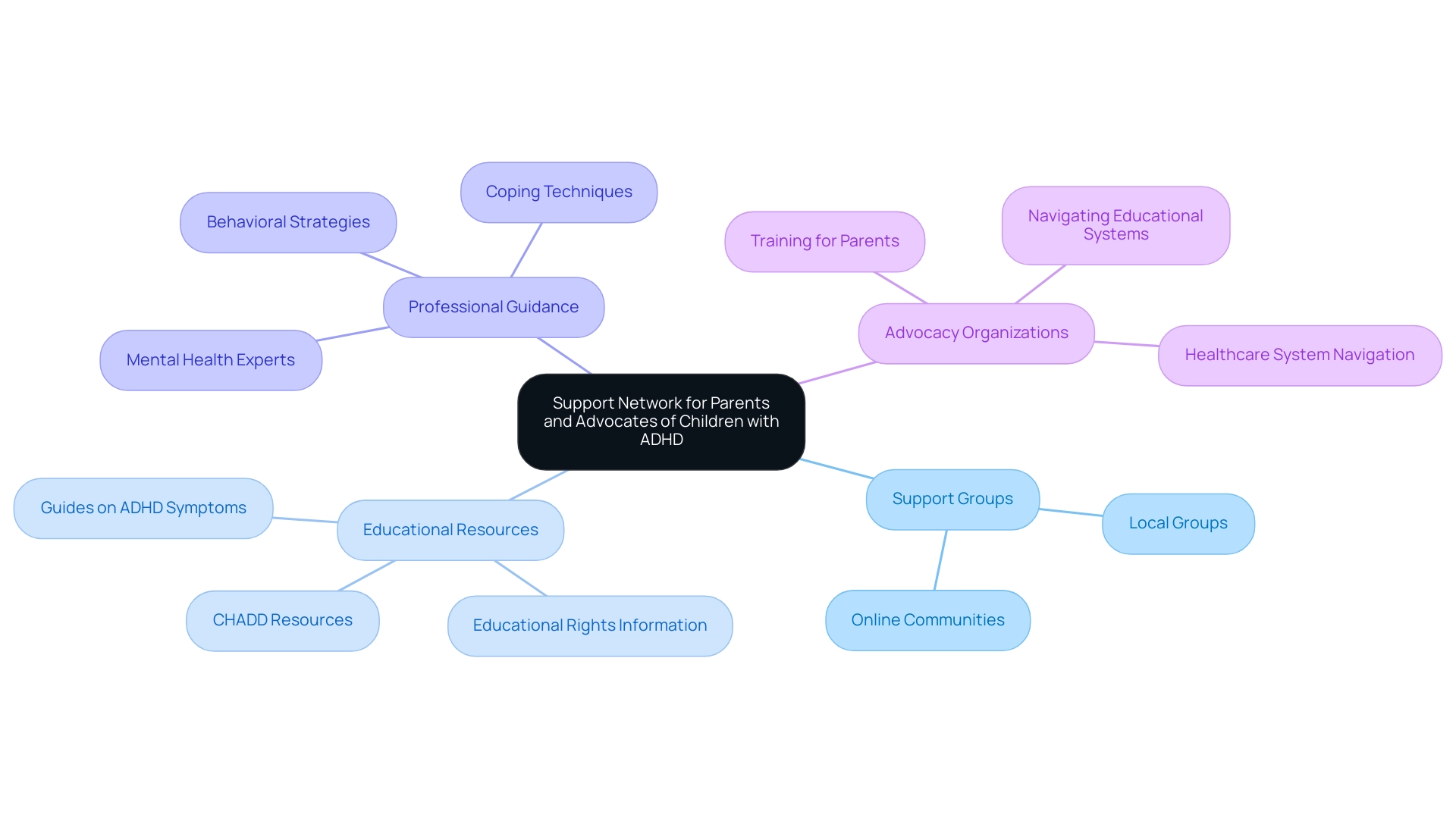
Conclusion
In conclusion, ADHD Combined Presentation is a multifaceted condition that intricately weaves together symptoms of inattention and hyperactivity-impulsivity, profoundly impacting children's lives. For parents and advocates, understanding its characteristics is vital; it empowers them to recognize symptoms and seek the right support. This article underscores the significance of accurate diagnosis, highlighting the necessity for thorough evaluations and the consideration of co-occurring conditions that may complicate management.
To navigate life with ADHD Combined Presentation effectively, families can implement strategies such as:
- Establishing routines
- Minimizing distractions
- Utilizing visual aids
These approaches not only pave the way for academic success but also enhance overall well-being. Additionally, building a strong support network is essential, offering emotional backing and access to valuable resources. Engaging with support groups, educational organizations, and mental health professionals fosters a collaborative environment, empowering parents and advocates on their journey.
Ultimately, nurturing a deeper understanding of ADHD Combined Presentation equips families with the tools they need for effective management and advocacy. By recognizing the complex nature of this condition and employing tailored strategies, families can help their children thrive despite the challenges ADHD presents. The path may be intricate, but with the right knowledge and support, success is indeed within reach for those affected. Together, let’s embrace this journey with compassion and determination.
Frequently Asked Questions
What is ADHD combined presentation?
ADHD combined presentation is a neurobehavioral condition that includes symptoms from both the inattentive and hyperactive-impulsive categories, affecting children's ability to sustain attention, manage impulses, and regulate activity levels.
What are the common traits of children with ADHD combined presentation?
Common traits include difficulty following through on tasks, excessive fidgeting, and challenges in waiting for their turn in conversations or activities.
How does ADHD combined presentation affect daily life?
The overlapping symptoms can significantly impact academic performance, social interactions, and overall well-being of children.
What does recent research indicate about the prevalence of ADHD combined presentation?
Recent studies suggest that ADHD combined presentation affects a significant percentage of the pediatric population, with notable occurrences among children.
Can you provide an example of how ADHD combined presentation manifests in real life?
For instance, a young individual may excel in creative tasks but struggle with organization and time management, highlighting the dual nature of strengths and challenges in these individuals.
What is the importance of a holistic approach to managing ADHD combined presentation?
A holistic approach is vital as it addresses the multifaceted nature of the condition, incorporating coaching and therapeutic interventions tailored to each child's unique needs.
What statistics are available regarding adults with ADHD and telehealth services?
Statistics reveal that 30.5% of adults with current ADHD have utilized telehealth services to obtain a prescription for medication since March 2020, indicating a growing awareness of accessible treatment alternatives.
What are the three main categories of symptoms for ADHD combined presentation?
The three main categories are inattention (difficulty maintaining focus), hyperactivity (excessive fidgeting and inability to stay seated), and impulsivity (interrupting others and making quick decisions).
How prevalent is attention deficit care among youth with Medicaid?
Research shows that nearly 1 in 5 youth with Medicaid receive attention deficit care from nurse practitioners and psychiatric nurses.
How do ADHD symptoms vary among different racial and ethnic backgrounds?
A case study reveals that White non-Hispanic youths have the highest occurrence of attention issues at 13.4%, followed by Black non-Hispanic individuals at 10.8% and Hispanic youths at 8.9%, indicating the need for tailored approaches in diagnosis and treatment.
How can parents and supporters effectively advocate for children with ADHD combined presentation?
By becoming aware of the typical indicators of ADHD combined presentation, parents and supporters can seek appropriate resources and strategies to foster their children's growth.




